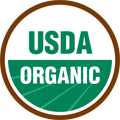|
What does it mean to be USDA Certified Organic? It probably means more than you thought... 
First, let's start with the definition of the term "organic". When you hear someone is an organic farmer or gardener, what assumptions do you make? No pesticides? No herbicides? No chemical fertilizers? Did you know there is a specific, legal definition for the term "organic" and specific rules for production when it comes to food products? In fact, The United States Department of Agriculture (USDA) National Organic Program (NOP) states that it is illegal for a food producer (crops, livestock, and processed foods) to use the term "organic" if they sell over $5,000 in product a year, unless the producer is USDA Certified. (I will explain what it takes to become certified later.) If a producer sells under $5,000 and uses the term "organic", they are required to follow NOP rules, can be audited and are subject to fines if they are not following the rules. As you will see below, organic growing means much more than "pesticide and herbicide free" or "naturally gown" (an undefined term). But here's where the water gets muddy. The National Organic Program (NOP) rules do not extend to pet foods, fabrics, cosmetics, body care products, over-the-counter medications, dietary supplements, fertilizers, and soil amendments! Many personal care products and dietary supplement companies, and some food manufacturers, have made the word "organic" or "organics" part of their brand name and thereby mislead consumers. Unless the product displays the USDA organic seal, organic labels and claims on these types of products are not backed by the same rigorous standards as foods. Education is the best tool when making buying decisions concerning products we come into contact with in the kitchen, in the bath and in the garden! Here's an outline of National Organic Program (NOP) requirements for certification:
- soil building practices (leaving the soil better than the previous year)
- crop rotations (to break disease, pest and weed cycles and build fertility) - soil and water conservation practices (to prevent erosion and run-off pollution) - buffers to neighboring non-organic fields seed sources (non-GMO, untreated and certified organic if available) - fertility management practices (cover crops, crop rotation) - all soil input applications integrated pest management (weeds, insects, diseases) practices including beneficial and buffer plantings - post-handling practices labeling As you can see, there is a lot of detail, hard work and financial investment that goes into certifying that products are "organic" and meet the high NOP standard! It's not just what you can't spray or use as fertilizers that defines organic production, it's also what you must do to protect and build natural resources. I know many gardeners and farmers who produce products sustainably, use non-chemical and non-GMO inputs, are good stewards of the land but choose not become certified because of the financial and paperwork burden or for political reasons. That's why it's best to know your farmer and where your food comes from! For us at Windcrest Farm, the USDA Certified Organic symbol gives educated customers that we don't meet personally a way to know how we grow our products. |